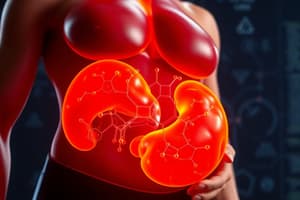Podcast
Questions and Answers
What is the role of macrophages in relation to disease development?
What is the role of macrophages in relation to disease development?
- They produce essential fatty acids.
- They play a critical role in disease development and progression. (correct)
- They help in repairing tissues.
- They facilitate oxidation of lipids.
Which of the following is a consequence of lipid oxidation on food quality?
Which of the following is a consequence of lipid oxidation on food quality?
- Development of off-flavors and rancidity. (correct)
- Enhanced shelf life of food products.
- Increased nutritional value.
- Stabilization of essential fatty acids.
What happens to the availability of essential fatty acids due to oxidative degradation?
What happens to the availability of essential fatty acids due to oxidative degradation?
- It remains unchanged.
- It increases dramatically.
- It contributes to better metabolism.
- It decreases, reducing absorption in the body. (correct)
What type of compounds are produced when fats oxidize, often leading to rancidity?
What type of compounds are produced when fats oxidize, often leading to rancidity?
Which step in β-oxidation specifically requires ATP?
Which step in β-oxidation specifically requires ATP?
What is the primary role of carnitine in fat metabolism?
What is the primary role of carnitine in fat metabolism?
Which of these health concerns is linked to oxidized lipids?
Which of these health concerns is linked to oxidized lipids?
Which energy-rich compound is converted during fatty acid activation?
Which energy-rich compound is converted during fatty acid activation?
What is the primary purpose of carnitine in fatty acid metabolism?
What is the primary purpose of carnitine in fatty acid metabolism?
Which of the following is NOT a step in the β-oxidation process?
Which of the following is NOT a step in the β-oxidation process?
What effect does the presence of antioxidants have on fat oxidation?
What effect does the presence of antioxidants have on fat oxidation?
Which of the following factors does NOT influence fat oxidation?
Which of the following factors does NOT influence fat oxidation?
How does β-oxidation affect the fatty acid chain length?
How does β-oxidation affect the fatty acid chain length?
What is a potential downside of hydrogenation of fatty acids?
What is a potential downside of hydrogenation of fatty acids?
Why are polyunsaturated fatty acids more prone to oxidation?
Why are polyunsaturated fatty acids more prone to oxidation?
What is the result of each cycle in β-oxidation?
What is the result of each cycle in β-oxidation?
What is one major consequence of fat oxidation in food?
What is one major consequence of fat oxidation in food?
Which pathways are involved in lipid oxidation?
Which pathways are involved in lipid oxidation?
What component initiates enzymatic oxidation of fatty acids?
What component initiates enzymatic oxidation of fatty acids?
How does the concentration of lipoxygenase affect lipid oxidation?
How does the concentration of lipoxygenase affect lipid oxidation?
What triggers the initiation phase of autoxidation?
What triggers the initiation phase of autoxidation?
What types of compounds can be produced during lipid autoxidation?
What types of compounds can be produced during lipid autoxidation?
During photooxidation, which sensitizers can facilitate oxidation?
During photooxidation, which sensitizers can facilitate oxidation?
What is primarily generated during the lipid auto-oxidation process?
What is primarily generated during the lipid auto-oxidation process?
What happens to free radicals during the termination phase of autoxidation?
What happens to free radicals during the termination phase of autoxidation?
What type of fatty acids are primarily affected by fat oxidation?
What type of fatty acids are primarily affected by fat oxidation?
Which of the following describes the active site of lipoxygenase?
Which of the following describes the active site of lipoxygenase?
What characterizes the lag phase in enzyme-catalyzed lipid oxidation?
What characterizes the lag phase in enzyme-catalyzed lipid oxidation?
Which of the following is NOT a factor contributing to lipid oxidation?
Which of the following is NOT a factor contributing to lipid oxidation?
Why is understanding lipid oxidation important in food science?
Why is understanding lipid oxidation important in food science?
What is a consequence of meat products being exposed to direct light in supermarkets?
What is a consequence of meat products being exposed to direct light in supermarkets?
Which process is significantly faster than autoxidation?
Which process is significantly faster than autoxidation?
What type of fats are typically solid at room temperature?
What type of fats are typically solid at room temperature?
Which of the following fats is considered the healthiest due to its capability to lower total cholesterol?
Which of the following fats is considered the healthiest due to its capability to lower total cholesterol?
What is the main health benefit of eating more unsaturated fats?
What is the main health benefit of eating more unsaturated fats?
Which type of unsaturated fat contains more than one double bond?
Which type of unsaturated fat contains more than one double bond?
Which food is a rich source of polyunsaturated fats?
Which food is a rich source of polyunsaturated fats?
How does the body predominantly produce cholesterol?
How does the body predominantly produce cholesterol?
What is the main characteristic of unsaturated fats compared to saturated fats?
What is the main characteristic of unsaturated fats compared to saturated fats?
Which of the following is a source of monounsaturated fats?
Which of the following is a source of monounsaturated fats?
What configuration do most naturally occurring unsaturated fats have?
What configuration do most naturally occurring unsaturated fats have?
Which type of fatty acid contains only one double bond?
Which type of fatty acid contains only one double bond?
What health benefit is associated with omega-3 fatty acids?
What health benefit is associated with omega-3 fatty acids?
Which of the following is a characteristic of trans fats?
Which of the following is a characteristic of trans fats?
What is one of the biological roles of unsaturated fatty acids?
What is one of the biological roles of unsaturated fatty acids?
Flashcards
Fat Oxidation
Fat Oxidation
The breakdown of fats by oxygen, leading to changes in taste, flavor, and the formation of potentially harmful substances.
Autoxidation
Autoxidation
A chain reaction involving free radicals and oxygen that degrades unsaturated fatty acids, contributing to food spoilage.
Initiation Phase of Autoxidation
Initiation Phase of Autoxidation
The initial stage of autoxidation where free radicals are generated in fats, often triggered by light, heat, or metal catalysts.
Propagation Phase of Autoxidation
Propagation Phase of Autoxidation
Signup and view all the flashcards
Termination Phase of Autoxidation
Termination Phase of Autoxidation
Signup and view all the flashcards
Carbonyls
Carbonyls
Signup and view all the flashcards
Photooxidation
Photooxidation
Signup and view all the flashcards
Enzymatic Oxidation
Enzymatic Oxidation
Signup and view all the flashcards
Lipid Autoxidation
Lipid Autoxidation
Signup and view all the flashcards
Initiation Phase
Initiation Phase
Signup and view all the flashcards
Propagation Phase
Propagation Phase
Signup and view all the flashcards
Termination Phase
Termination Phase
Signup and view all the flashcards
Lipoxygenases
Lipoxygenases
Signup and view all the flashcards
Hydroperoxides
Hydroperoxides
Signup and view all the flashcards
Beta-Oxidation
Beta-Oxidation
Signup and view all the flashcards
Fatty Acid Activation
Fatty Acid Activation
Signup and view all the flashcards
Carnitine
Carnitine
Signup and view all the flashcards
Carnitine Palmitoyltransferase (CPT)
Carnitine Palmitoyltransferase (CPT)
Signup and view all the flashcards
Lipid Oxidation in Food
Lipid Oxidation in Food
Signup and view all the flashcards
Lipid Oxidation and Health
Lipid Oxidation and Health
Signup and view all the flashcards
Nutritional Loss from Lipid Oxidation
Nutritional Loss from Lipid Oxidation
Signup and view all the flashcards
Off-Flavors from Lipid Oxidation
Off-Flavors from Lipid Oxidation
Signup and view all the flashcards
What is carnitine's role in fat metabolism?
What is carnitine's role in fat metabolism?
Signup and view all the flashcards
What is beta-oxidation?
What is beta-oxidation?
Signup and view all the flashcards
What happens in the first step of beta-oxidation?
What happens in the first step of beta-oxidation?
Signup and view all the flashcards
What happens in the second step of beta-oxidation?
What happens in the second step of beta-oxidation?
Signup and view all the flashcards
What happens in the third step of beta-oxidation?
What happens in the third step of beta-oxidation?
Signup and view all the flashcards
What happens in the fourth step of beta-oxidation?
What happens in the fourth step of beta-oxidation?
Signup and view all the flashcards
How do unsaturated fatty acids influence fat oxidation?
How do unsaturated fatty acids influence fat oxidation?
Signup and view all the flashcards
How can fat oxidation be prevented or controlled?
How can fat oxidation be prevented or controlled?
Signup and view all the flashcards
Monounsaturated Fatty Acid (MUFA)
Monounsaturated Fatty Acid (MUFA)
Signup and view all the flashcards
Polyunsaturated Fatty Acid (PUFA)
Polyunsaturated Fatty Acid (PUFA)
Signup and view all the flashcards
Omega-3 Fatty Acids
Omega-3 Fatty Acids
Signup and view all the flashcards
Omega-6 Fatty Acids
Omega-6 Fatty Acids
Signup and view all the flashcards
Cis vs. Trans Configuration
Cis vs. Trans Configuration
Signup and view all the flashcards
Saturated Fats
Saturated Fats
Signup and view all the flashcards
Unsaturated Fats
Unsaturated Fats
Signup and view all the flashcards
Monounsaturated Fats
Monounsaturated Fats
Signup and view all the flashcards
Polyunsaturated Fats
Polyunsaturated Fats
Signup and view all the flashcards
Bad Cholesterol (LDL)
Bad Cholesterol (LDL)
Signup and view all the flashcards
Good Cholesterol (HDL)
Good Cholesterol (HDL)
Signup and view all the flashcards
Triglycerides
Triglycerides
Signup and view all the flashcards
Oxidative Stability
Oxidative Stability
Signup and view all the flashcards
Study Notes
Oxidation of Fats
- Oxidation of fats, particularly unsaturated fatty acids, is a crucial biochemical process.
- This process affects food quality, nutritional value, and metabolic functions.
- It results in aroma and flavor changes, color loss, nutrient loss, and the formation of potentially harmful substances.
- This process reduces shelf life and impacts food quality and human health.
- Oxidation is a chemical process where fats react with oxygen forming various byproducts.
Mechanisms of Fat Oxidation
- Lipid oxidation is a major contributor to food spoilage.
- It involves gradual oxidation of unsaturated fatty acids in fats.
- This process happens when exposed to oxygen, light, or metal ions.
- Three primary pathways: autoxidation, photooxidation, and enzymatic oxidation.
1. Autoxidation
- Autoxidation is a free radical chain reaction between unsaturated fatty acids and oxygen.
- Initiation phase: oil molecules generate free radicals (influenced by light, heat, or metal catalysts).
- Propagation phase: free radical chain reaction.
- Termination phase: free radicals react to form stable, non-free radical compounds.
- Rancidity can develop as the process continues.
- Can lead to formation of aromatic compounds, mainly carbonyls, impacting flavors and aromas of meat.
2. Enzymatic Oxidation
- Enzymatic oxidation involves enzymes like lipoxygenases.
- These enzymes catalyze the oxidation of fatty acids, leading to hydroperoxides and other oxidized products.
- This affects flavor changes and nutritional degradation.
- Enzyme-mediated mechanism also initiates lipid oxidation.
- Lipoxygenase is the primary enzyme involved.
- Enzyme concentration directly impacts the pace of oxidation.
3. Photooxidation
- Photooxidation occurs when light energy facilitates fat oxidation.
- This process is particularly relevant for food products exposed to light.
- This process leads to off-flavors and nutrient loss.
- Photo-oxidation is faster than autoxidation.
Studying That Suits You
Use AI to generate personalized quizzes and flashcards to suit your learning preferences.




